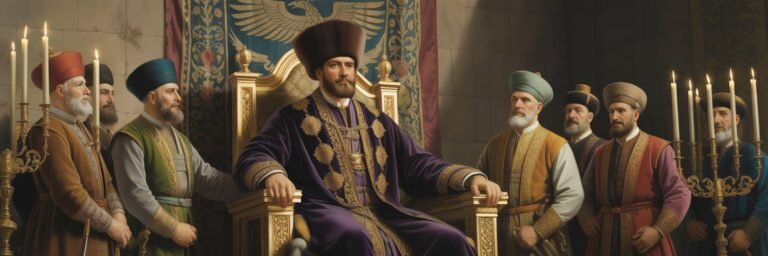INTRODUCTION
The decline and eventual collapse of the once formidable Ottoman Empire, an extensive realm spanning three continents and lasting approximately six centuries, remains a subject of profound fascination and study for historians and scholars worldwide. The Empire, which commenced with a modest Anatolian kingdom, grew to encompass key territories in modern-day Turkey, Greece, Egypt, and Southeast Europe, and even reached the gates of Vienna at its zenith. However, at the dawn of the twentieth century, internal strife, conflicts, and economic challenges led to the collapse of this once vast Empire, marking a definitive end to its influential reign.
HISTORICAL BACKGROUND
The Ottoman Empire’s story began amidst the violent convulsions of the late Middle Ages when an Anatolian ghazi named Osman I expanded his territories at the expense of the declining Byzantine Empire. It was a time characterized by power shifts and the emergence of new powers on the world stage. The rapidly expanding Ottoman dynasty mastered the military techniques of the time, impressively amalgamating heavy cavalry, light archers, and foot infantry into a formidable fighting force that was both versatile and resilient.
Their empire continued to grow, with significant achievements such as the capturing of Constantinople under Mehmed the Conqueror in 1453, leaving a lasting legacy across multiple ages. However, after Suleiman the Magnificent’s reign ended in 1566, the empire began facing repeated struggles both internally and externally.
THEORIES AND INTERPRETATIONS
There exist several theories that attempt to explain the decline of the Ottoman Empire, which can be broadly categorized under internal and external factors. Internally, many scholars argue that it suffered from a crisis of leadership after Suleiman, marked by a series of incompetent rulers. Feuding among potential heirs, often resulting in brutal fratricide, weakened the dynasty.
Simultaneously, the empire’s financial situation was progressively eroding due to corruption, inflation, and costly wars. The traditional timar system of land administration was gradually supplanted by private land ownership, leading to a concentration of wealth that sowed socio-economic disparities and discontent.
Externally, the empire became increasingly militarily overextended, defending its broad frontiers. European powers, aided by their geographical discoveries, began establishing new trade routes, bypassing the Ottomans and severely harming their economic interests. Furthermore, the military advancements of these rivals, particularly in the domain of artillery and navy, began to surpass Ottoman capabilities.
MYSTERIES AND CONTROVERSIES
The contradictory historical interpretations of the Ottoman decline spark significant academic debates. Some theorists argue that the empire did not decline in the traditional sense but merely stagnated relative to other powers who advanced at a more rapid pace in technological, political, and economic domains.
At the heart of this controversy lies the ‘Sick man of Europe’ label, initially coined by Tsar Nicholas I of Russia. The phrase gives an impression of a once mighty empire, now tottering and decayed. While the Ottoman Empire undoubtedly faced serious challenges in its final century, its ability to withstand these pressures for a considerable period indicates its inherent resilience and strength.
SYMBOLISM AND CULTURAL SIGNIFICANCE
The Ottoman Empire was more than a political entity; it was a civilization, complete with its unique language, arts, and architectural styles. From the captivating calligraphy of its scripts to the imposing dome of the Hagia Sophia, the legacy of this empire was ingrained into various aspects of life.
Its demise signified not only a political shift but also a severe cultural disruption. The empire, founded on Islamic principles with a touch of tolerant cosmopolitanism, was replaced by a secular, nationalist Turkish state under the leadership of Mustafa Kemal Atatürk. The cultural implications were felt far and deep, resulting in calculated erasure of certain parts of the Ottoman legacy as the new Turkey sought a radically different identity.
MODERN INVESTIGATIONS
Modern scholarship has made concerted attempts to investigate the empire’s collapse, focusing on understanding its complex socio-political and economic structure. Comprehensive studies of the empire’s records, combined with modern analytical tools, have allowed historians to challenge, refine, and even reject some traditional views of decline.
Emphasis has been shifting towards its remarkable capacity for reinvention and survival, as demonstrated by its substantial political and institutional reforms during the Tanzimat and Hamidian eras. There is a growing recognition that while the empire ended in 1922, a more nuanced understanding reveals periods of resurgence and enlightenment during its alleged ‘decline.’
LEGACY AND CONCLUSION
The Ottoman Empire’s legacy is as profound as its journey was eventful. It profoundly shaped the region’s cultural, architectural, and political landscapes, as evidenced in modern Turkey and beyond. Its institutions, from the bureaucratic to the religious, from the land framework to societal norms, left indelible marks on subsequent social arrangements.
The Empire’s collapse may be perceived as an inevitable consequence of mismanagement, external pressures, and the march of time. However, it is crucial to remember that during its six centuries of existence, it was a hub of cultural richness, military prowess, and political achievements, for much longer than it was a ‘Sick man of Europe.’
When Sultan Mehmed V’s reign ended abruptly in 1918, so did an era. The labyrinthine city of Constantinople, filled with minarets and mosques, bazaars and bathhouses, stood silent witness to the pivotal transformation from empire to republic. For better or worse, the echo of its fall reverberates even today, in the modern countries shaped by its indelible historical influence—the epic tale that was the Ottoman Empire.






